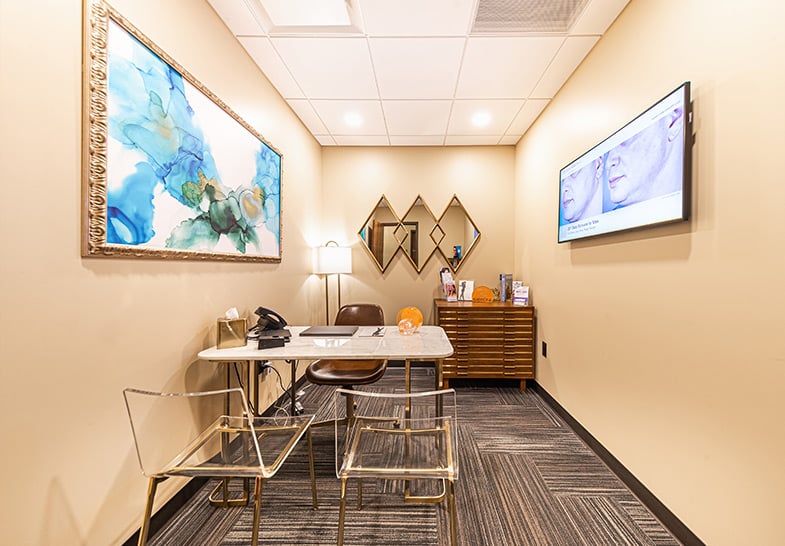Body Lift in Virginia, Washington D.C. and Maryland.
Embark on a journey of aesthetic excellence with The Naderi Center. Experience unparalleled artistry and precision for transformative beauty.
Achieve a Toned Look with Body Lift Benefits
A Body Lift at The Naderi Center is designed to transform and renew your figure. Guided by our experienced specialists, the procedure smooths, lifts, and redefines your body’s natural lines—helping you feel stronger, more confident, and proud of your progress.
Youthful Appearance
Turn back the clock and rediscover a more youthful you. Our Body Lift removes excess skin and tightens what's left for a younger look.
Enhanced Contours
Reveal the toned, sculpted body hiding beneath the sagging skin. Gain natural-looking curves and contours.
Renewed Confidence
With a reshaped body, you'll experience a surge in self-esteem, ready to face the world anew.


What is Body Lift?
Sagging, loose skin around the waist is not uncommon, especially for people who have experienced a large weight loss or seen severe weight fluctuations. The normal aging process can also cause skin to droop, as it loses its youthful elasticity and shape. Even on a thinner individual, this billowy tissue will cause clothing to fit poorly, diminishing confidence in the appearance. Unfortunately, the excess skin does not only look unsightly, it can also rub and chafe on surrounding areas, limiting activities and mobility.
The body lift is a surgical procedure created specifically to restore a beautiful, youthful shape to the lower body. Also known as a belt lipectomy or circumferential tummy tuck, the procedure will lift, tighten, and sculpt the buttocks, thighs, hips, and stomach. For some individuals who have struggled with weight loss, the belt lipectomy may create a sculpted figure for the first time in their lives.

Body Lift Expected Results
Improve the appearance of sagging, droopy skin, fat, and tissue around the abdomen, lower back, and buttocks area
Achieve a trimmer and shapely figure while keeping your natural body proportions
- More smooth and tighter skin surface
Body Lift Summary

Moderate
General Anesthesia
4 to 6 hours
Circumferential or beltline, incision around the lower abdomen and above the buttocks
6-8 weeks
2 weeks
3-4 weeks
$18,000 – $20,000
Ideal Candidate for a Body Lift in Reston, VA, and Chevy Chase, MD
Almost anyone who is seeking an improvement in excess, loose skin and fat around their mid-section, and is in overall good health, may benefit from the body lift procedure. This surgical technique is especially good for those patients dealing with inches of loose skin following massive weight loss. Candidates should understand our surgeon’s technique, and be fully committed to the recovery process.
Good Candidates for Body Lift:
- Are at an ideal body weight
- Have significant sagging and loose soft tissue in one or more body areas, typically the abdomen and buttocks
- Women should have completed family planning and have achieved a satisfactory stable weight
- Are in good health
- Do not have any medical conditions that may delay and impair wound healing
- Have a positive outlook and realistic goals for what body lift surgery can accomplish
- Are non-smokers
Cost of a Body Lift in Reston, VA, and Chevy Chase, MD
There are a variety of factors that determine the overall cost of your belt lipectomy.
- Surgeons fee: $18,000 – $20,000
- Anesthesia Fee: Depends on the length of the procedure
- Hospital and Surgical Facility Fees: Depends on the length of the procedure
- Post-Surgery Garments: Included with surgeon’s fee at The Naderi Center
- Pre-Surgical Medical Clearance and Lab Tests: Usually covered by medical insurance
- Medication Costs: Usually covered by medical insurance
- Follow-Up Visits: Included with surgeon’s fee at The Naderi Center
Testimonial
“I had the most wonderful experience with Naderi Center. Dr. Naderi and staff are incredible. They are all very nice and helpful, and really make you feel like your individual experience is important to them. From the very first visit, through the surgery, and all post op appointments, Dr. Naderi always spent time answering any questions and going over everything in completion. I never once waited on him; all my appointments ran on schedule. His phones are always answered by helpful staff members, and he answers emails almost immediately.”
Body Lift Surgical Techniques
The belt lipectomy procedure will take between four and six hours to perform. You will be under general anesthesia for the procedure. Our plastic surgeons will perform the procedure at a nearby accredited, luxurious center. In most situations, an overnight hospital stay is recommended for maximum patient comfort.
Steps to performing a Body Lift
Step 1
Beltline Incision
Step 2
Excision and Removal of Tissue
Unwanted fatty tissue, excess skin, and muscle from the stomach, flanks, and lower back are excised.
Step 3
Liposuction
Step 4
Body Sculpting
Step 5
Closure of Incision and Placement of Surgical Drain
Body Lift Video
Preparation for a Body Lift
At The Naderi Center, we believe the success of any cosmetic procedure can be improved with proper patient preparation. We go above and beyond to make sure that our patients are medically, emotionally, and physically ready for cosmetic surgery.
Please review our detailed instructions on Body Lift Preparation in link below.
Recovery after a Body Lift
The belt lipectomy recovery period will take about two weeks depending on the extensive nature of the surgery. Most patients are comfortable returning to work in 10-14 days. Moderate pain and discomfort can be expected following a belt lipectomy. Our plastic surgeons will prescribe appropriate pain medications to help during this time. Bruising and swelling are also common. A compression garment will need to be worn for several weeks to limit swelling. Small drainage tubes are put in place after the body lift procedure and then removed in five to ten days.
Adequate rest following a body lift surgery is essential for proper healing. Patients should fill their medications prior to the body lift procedure and make sure they are on hand when returning home from surgery. Assistance from a loved one or friend is important for the first several days following a body lift, as patients are usually sore and tired. Heavy lifting (including that of small children) and strenuous exercise must be postponed for four to six weeks following surgery.
Risks, Safety, and Potential Complications of Body Lift Surgery
Our specialists have been performing the body lift procedure for more than a decade. While the procedure is considered a safe technique and can provide satisfying results, there is a small chance for complications to occur. There are no “common side effects” but there are possible complications, however, by choosing an experienced, board-certified cosmetic surgeon, patients can ensure their belt lipectomy is safe and will deliver satisfying results.
Possible Complications after a Belt Lipectomy can include:
- Risk of general anesthesia
- Excessive bleeding or hematoma
- Infection
- Poor incision healing
- Skin changes or discoloration
- Fluid accumulation or seroma
- Nerve damage or numbness in the skin
- Death of fatty tissue or fat necrosis
- Reoccurrence of saggy skin, especially if weight is gained
- Chronic pain
- Recurrent looseness of skin
- Asymmetric results
- Need for revision surgery
- Unfavorable scar formation
Body Lift Specialists
The Naderi Center’s body lift is ideal for anyone dealing with sagging, lax skin and tissue around the stomach, thighs, flanks (love handles), and lower back. Our exclusive breast and body surgeons have extensive experience in body contouring procedures and have been providing the technique to their patients for over a decade. A comprehensive body lift consultation will be arranged prior to scheduling the surgical procedure. At this time, our expert plastic surgeons will go over the patient’s medical history and current medications prior to performing a physical evaluation.
Once our surgeon has explained the belt lipectomy technique in full, our doctor will address concerns and answer any remaining questions. Our surgeon will use before and after photographs of the recent body lift procedures to assist patients in visualizing their potential results.

After the recovery, risks, and costs have been discussed, our specialists will determine if the belt lipectomy is the best procedure for the individual’s situation. Afterward, you will meet with one of our caring and knowledgeable patient coordinators who will help guide you through the logistics of scheduling surgery, costs, recovery timeline, and pre-surgical clearance.
Do you still have questions about the body lift procedure? To find out more, contact the Naderi Center’s Reston, Virginia office at 703-481-0002 or the Chevy Chase, Maryland office at 301-222-2020. Virtual consultations are available for those patients traveling from outside of the immediate area.
Body Lift FAQs
What is a body lift procedure from the Naderi Center?
A body lift, sometimes referred to as a belt lipectomy, is a surgical procedure designed to remove the lax skin and fat from the abdomen, backside, and hips to improve the body contour.
Can a Belt Lipectomy be combined with other Procedures?
Yes, a Belt Lipectomy can be combined with other procedures such as a breast lift, breast augmentation, thigh lift, arm lift, or additional procedures to address specific upper body lift or body enhancement desires. Combining procedures can help achieve more comprehensive results and streamline the overall recovery process. Our experienced, board-certified plastic surgeons at the Naderi Center can assess your goals and recommend the best combination of procedures to meet your individual needs.
Will I make a good candidate for a body lift?
Anyone who is struggling with excess, lax skin around their waist and lower body may make a good candidate for the body lift procedure. Patients should be at or close to their ideal body weight before the procedure. It is also important candidates be in generally good health, understand the surgical procedure and recovery commitment, and hold realistic expectations for the final results.
How long can I expect my body lift procedure to take?
Depending on the individual patient’s situation, a body lift can take from three to six hours to complete.
Will my body lift leave scars?
Yes, a scar will remain along the incision lines, following the procedure. While the scar will fade somewhat over time, it will remain visible. Once you have healed from surgery your surgeon will prescribe a scar creme as well as advise you on techniques to minimize the appearance of your scars.
When can I return to work after my body lift procedure?
Most people feel well enough to return to work about two weeks after their body lift procedure at the Naderi Center. A belt lipectomy can encompass a number of different procedures, your surgeon will be able to estimate a timeframe in which you will be healed enough to return to work.
What body lift office is near me?
If you live in the states of Virginia or Maryland, The Naderi Center for Plastic Surgery and Dermatology offers body lift among its services. For a full list of services, please visit our Locations page.